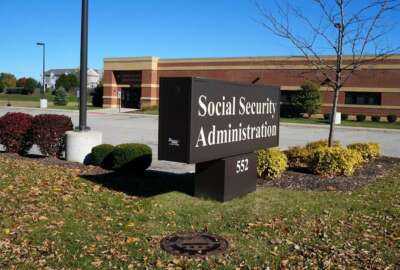How 5 federal agencies are handling employee reentry in the new year — for now
Of the agency reentry plans that Federal News Network recently reviewed, it's mostly managers and supervisors who appear primed to return to the office, at least...
As the new year approaches, agency reentry plans remain as ambiguous and complicated as ever.
Many agencies tossed the reentry plans they made earlier this summer for the fall when the delta variant became widespread and the Biden administration issued a vaccine mandate for the entire executive branch.
The vast majority of federal employees are vaccinated. But that milestone, at least for some agencies, won’t trigger a mass return to federal offices for employees.
The plans that Federal News Network recently reviewed suggest some federal managers, supervisors and senior executives will return to their offices with more frequency in early January, but bargaining unit employees won’t face similar requirements until later.
Under guidance from the Biden administration, employees are supposed to get at least 30 days’ advanced notice before returning to an office or work site.
The National Treasury Employees Union said the agencies where it has members are following that guidance so far. The union said the Nuclear Regulatory Commission gave employees appropriate notice and has already reopened offices. Most agencies, however, haven’t indicated firm reentry dates, the union said.
“NTEU is actively engaged in bargaining with agencies over returning to federal workplaces, including expansion of telework programs,” Tony Reardon, the union’s national president, said in a statement to Federal News Network. “Most agencies where NTEU represents employees have yet to announce a timeframe for returning employees to federal offices and work sites, including the Department of Health and Human Services, the IRS and the Environmental Protection Agency.”
The current landscape also suggests just how difficult the planning efforts have been, as agencies are still processing medical and religious exception requests to the president’s vaccine mandate — and are juggling the omicron variant, collective bargaining obligations and external pressure from Congress and others at the same time.
Here’s a roundup of where some federal agencies stand on reentry. This is not an exhaustive list of agencies’ plans.
Agriculture Department
The Agriculture Department will begin its “full-fledged return to the workplace for all USDA employees” on Jan. 3, according to its workplace safety plan, which the agency confirmed to Federal News Network.
USDA didn’t respond to a question about how many employees it expects will return on or near the Jan. 3 date. A USDA employee familiar with the department’s plans said mostly managers and supervisors will return to the office in early January, not necessarily bargaining unit employees.
“Returning to the workplace will be a process,” the USDA plan reads. “Once the return to the workplace process begins, we expect it will be a phased approach that is dependent on satisfaction of any labor relations obligations.”
The department has said it will give employees at least 45 days’ advanced notice before asking them to return to in-person work. USDA said it expects all employees will have returned to the workplace by March 14.
Telework and remote work remain part of the USDA’s workforce plan, which Secretary Tom Vilsack advertised during his first few months back at the department. The department finalized a new telework policy last month, which lets employees work from home up to eight days each biweekly pay period.
“The newly established telework and remote work program will allow us to recruit and retain the best talent that reflects the diversity of our country, restore the confidence of our employees and improve morale among our workforce,” Oscar Gonzales, USDA’s assistant secretary for administration, wrote in a Nov. 29 email to employees, which Federal News Network obtained. “We must work together to make USDA a safe, fair, equitable and rewarding place for all employees. We want our staff to enjoy coming to work every day, doing the important work that will help to move our country forward.”
According to the new USDA policy, all employees, regardless of their tenure, grade, job series, title or supervisory status are eligible for telework. Only employees whose job requires their daily presence or daily access to equipment or classified materials that they can’t use remotely are ineligible for telework.
The policy also allows individual USDA mission areas and subcomponents to develop their own remote work policies and review positions that might be eligible for such arrangements. In general, the department said it will use remote work as a way to retain talented employees who have to move and would otherwise need to leave USDA, and to recruit new employees with specialized skills who otherwise don’t want to move for personal reasons.
Remote work will also help the department achieve real estate and other business cost savings, reduce the costs of filling vacancies when candidates have to move and increase employee work-life balance and morale, USDA said.
Social Security Administration
The Social Security Administration announced in early November that it would plan to bring employees back to the office starting Jan. 3, at which point it would end its work-from-home-by-quarantine policy.
The majority of employees would still be able to telework, with some positions and SSA functions eligible for as much as five days a week, SSA said at the time.
But SSA’s specific reentry plans are still up in the air.
“Given the need to provide employees with sufficient notice of when we expect them to return and the fact that labor negotiations are ongoing, we will have a later reentry date than what was initially proposed,” an SSA spokeswoman said in an email to Federal News Network. “Once we resolve when and how we will reenter, we will implement a communications campaign to notify the public. Acting Commissioner [Kilolo] Kijakazi, along with senior leadership, began reentry on Dec. 1.”
Rich Couture, president of American Federation of Government Employees Council 215, said SSA and the union began negotiations during the first full week of December. The two parties have one more bargaining session later this week before the holidays.
“Reentry is a process, which is underway,” the agency’s spokeswoman said. “Labor negotiations, required by law, are a part of that process. We respect our unions and want them to help us with the best plan to safely return to our new normal.”
But from Couture’s perspective, SSA and AFGE still seem far apart from an agreement. He said SSA components will require different plans for each component, and the agency hasn’t shared how it will, for example, safely reopen hearing offices while dealing with a separate and unique set of challenges in reopening the field offices to employees and the public across the country.
“We want to be able to cooperate with the agency,” Couture said. “We want to get this work done. We want to begin this process that affords employees respect in the process… while being able to give stakeholders a timetable for when the agency will reopen. But that’s going to require the agency to be open about its plans.”
In its draft reentry plan, SSA said it would give employees at least 30 days’ advanced notice before asking them to return to in-person work.
Couture said he’s “shocked” with how the negotiations and discussions on the reentry process, among other topics, have gone during the last year. He said he expected more collaboration under the Biden administration, which has touted the utility of federal unions.
“I am shocked that there is continued resistance to partnership,” he said. “There is continued resistance to open and productive sharing with the union. We still have no resolution on our contract. We’ve obviously had a difficult time with respect to this reentry process. Many of my colleagues would share this frustration that under an expressly pro-union president, why is it this hard?”
National Science Foundation
The National Science Foundation has executive leaders to begin returning to the office a few days a week starting Jan. 4, according to recent emails obtained by Federal News Network.
Leadership will start reviewing which positions might be eligible for remote work or expanded telework programs. All other staff will remain on maximum telework.
“This is the first of several activities and milestones for the agency that will span the next several months,” NSF Director Sethuraman Panchanathan and Dave Verardo, president of the AFGE local representing agency employees, said Friday in a joint message to the workforce. “Throughout the process, we will evaluate and evolve our approach and plans based on what we learn as an organization and external factors we need to consider. Please rest assured that we are watching the Omicron variant situation closely and will be ready to shift the plan as necessary.”
In February, NSF leadership will continue to evaluate telework and remote work options. Division directors and deputy directors will start returning to the office with more frequency, and the agency will inform the rest of the workforce about their reentry plans then. Supervisors will talk to their employees about their schedules and needs, Panchanathan and Verardo said.
Nearly all NSF employees will begin returning, with safety protocols, to agency headquarters in March, according to the message. At that point, NSF will make its final decisions about positions eligible for expanded telework and remote work.
This timeline, which NSF announced in a Dec. 17 email, is more detailed than the plans the agency has previously announced.
In a brief interview, Verardo said the initial messages about NSF’s reentry plans prompted confusion and some anxiety among some employees and managers, who wanted to see top leadership give a heartier endorsement of telework, remote work and recommendations from a group of agency staff who studied hybrid work models and surveyed the workforce about their preferences earlier this year.
That group, made up of employees, labor and management, recommended NSF consider new telework and remote work arrangements, efforts the team said would expand and diversify NSF’s recruiting base. The team proposed arrangements where employees telework regularly but visit the office twice a pay period, telework but visit the office less frequently or live and work remotely.
The report, which the team submitted to Panchanathan back in July, also suggested specific criteria for evaluating telework and remote work requests.
NSF confirmed the agency’s latest plans and said it didn’t have any further comments.
“Many of you have been asking why action is needed now,” Panchanathan and Verardo wrote. “Quite simply, we are working within the framework that the Biden-Harris administration has laid out regarding its clear expectation that agencies work toward a hybrid work model. Therefore, we need to be prepared for our new posture once we are on the other side of the pandemic. We have learned many things and created new flexibilities in the past months that we will carry into our future work environment. Once again, your safety is a priority as we work together to fulfill the agency’s mission.”
Environmental Protection Agency
Political appointees, senior executives and Title 42 managers at EPA will also begin returning to their offices on Jan. 3, an agency spokeswoman told Federal News Network.
These leaders will start working from an EPA office one day a week and will increase their office presence over the course of three successive pay periods before establishing a normal work schedule, the spokeswoman said.
Senior political leaders began reporting to physical office spaces back on Nov. 22, the agency said.
“Under the agency’s new policies, some employees have expanded work hours, and can apply for expanded telework and remote work,” the EPA spokeswoman said. “The agency continues to work with their union partners on reentry plans and flexibilities for bargaining unit members.”
Again, EPA’s reentry timeline to date applies only to non-bargaining unit employees. The agency did, however, sign off on new telework and remote work agreements with AFGE.
Under the new policy, EPA bargaining unit employees can telework four days a week, or work two days per biweekly pay period at the office. Remote work is also a new part of the agency and union’s agreements.
Equal Employment Opportunity Commission
So far the Equal Employment Opportunity Commission hasn’t made any official plans to bring employees back to the office, the agency said.
But AFGE, which represents some employees at the agency, said it was surprised when EEOC Chairman Charlotte Burrows announced at a November town hall meeting that it would end maximum telework policies and would bring the workforce back to the office early next year.
AFGE said the agency hasn’t bargained over those changes.
“The EEOC has not made any changes to working conditions, as the agency is still operating under a maximum telework posture,” a spokeswoman said in an email to Federal News Network. “EEOC’s COVID Coordination Team is closely monitoring pandemic conditions and is currently in the process of drafting a proposed reentry plan with target dates in January for supervisors and managers and February for remaining staff in a phased reentry.”
AFGE has filed two unfair labor practice complaints against the agency. The union said EEOC has so far failed to meet its demands to bargain over the agency’s reentry plans.
When asked about the unfair labor practice complaints, the agency said the union will be able to bargain over the impact of implementation of its proposed reentry plan once the EEOC chairman clears it.
“We are strongly committed to bargaining in good faith with our union partners and to satisfying all collective bargaining obligations required by the EEOC’s collective bargaining agreement and the federal labor-management relations statute. We look forward to working with the union to ensure the safe return of EEOC’s workforce to our headquarters and field offices across the country so that we can restore greater public access to our critical services.”
Copyright © 2025 Federal News Network. All rights reserved. This website is not intended for users located within the European Economic Area.
Nicole Ogrysko is a reporter for Federal News Network focusing on the federal workforce and federal pay and benefits.
Follow @nogryskoWFED







